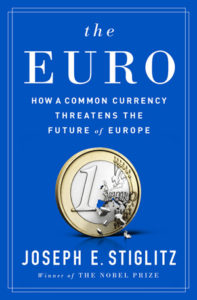

The Euro: How a Common Currency Threatens Europe
By Joseph Stiglitz
Publisher: W.W. Norton & Company
Recommended by Malcolm Campbell-Verduyn
The Noble Memorial Prize-winning American economist weighs in on the eurozone crisis in an analysis that is equally controversial for supporters as it is for detractors of the common currency. Both the diagnosis and solutions advanced in this book provide important contributions to debates on resolving this on-going debacle.
 The Habsburg Empire: A New History
The Habsburg Empire: A New History
By Pieter M. Judson
Publisher: Harvard University Press
Recommended by Louie Dean Valencia-García
I was not only drawn to this book as a historian of Europe, but as one interested in the ways that bureaucracies deal with new technologies. Judson challenges nationalist narratives by dusting off the history of a fallen power to show the dynamic nature of what the author, calls an “accidental empire.” At a moment in which the European Union is fighting off rampant “Eurosceptism,” Judson shows us how state and institution building and citizenship functioned under the Empress Maria Theresa (ruling from 1740 to 1780) and her later successors. The Habsburg Empire reframes the territory as one that was transitioning to a “liberal empire” during the mid-nineteenth century—profoundly interested in investing in education, culture, railroads, and canals, while turning medieval cities into modern metropolises. The empire reformed its industry, law, and economy in an attempt to win over both the rising liberal middle classes and peasants through a redefinition of what it meant to be a subject under the empire through the installation of local elections. Judson describes how such a wide variety of nationalisms, speakers of German, Polish, Czech, Hungarian, Ruthenian, Yiddish, French, Serbian, Slovenian, and Italian, were able to negotiate their own citizenship under the Habsburg empire through its bureaucracies—a lesson from which the European Union could take notes.
 The Heritage Arena: Reinventing Cheese in the Italian Alps
The Heritage Arena: Reinventing Cheese in the Italian Alps
By Cristina Grasseni
Publisher: Berghahn Books
Recommended by Hélène B. Ducros
This is not simply the story of cheese-making in Northern Italy. It is an account of the remaking of cheese as a cultural idea and economic resource in the quest for survival in the depopulated and economically depressed mountainous areas of Lombardia. The book invites us into dairy foodscapes and timescapes where an array of protagonists interconnect in valorizing place-based cheese production, maneuvering among a profusion of EU regulations about content traceability, production processes, sanitation and hygienic norms that transformed the industry, provoking the demise of the small-scale and seasonal transhumant cheese-making practices of alpeggiatori to the benefit of intensive dairy farming. Yet, as Alpine herders were replaced by cheese entrepreneurs, resistance and food activism emerged. The “war of the cheeses” is fought over heritage branding, marketing, regulation enforcement and geographic boundaries. Discussion of heritage-making inevitably brings questions of re-created authenticity as well as local memory and pride. This ethnographic journey shows how “tradition” is ridden with conflicts of interest and contested in its interpretation, showcasing and performance.
Published on November 1, 2016.




